After the peace and tranquility of our 15th floor breakfast, we were brought quickly back to reality by the fact that we would have to walk about a block to catch our bus. There was a construction project that made it impossible for our bus to make it to the hotel to pick us up. Traffic was just too much.
But before we knew it, we were at the Perfume River, and ready to set sail on our dragon boat adventure.
A little temple in the middle of the river.
As we got around to the other side of the little island, we noticed that someone was visiting the little temple. Isn't that cool?
We floated by a big group of water buffalo just enjoying a morning trip to the river.
Our first stop on this boat tour was the Thien Mu Pagoda, on the north bank of the Perfume River. This pagoda was built in 1601, but was demolished in the 19th century by a big storm. It was rebuilt a few years later, but not on the same foundation as the first pagoda.
Thien Mu means Heavenly Lady. The story behind this pagoda is that at a time when the local people were struggling to stay alive, a lady came down from the mountains and taught the people how to live in that area. Many generations later a man came wondering into that area, looking for a place to build his pagoda. The local people told the man about this lady, so he built his pagoda there in honor of her.
There are some young monks that live in this pagoda, some are less than 15 years old, and have not completely shaved their heads yet. They are still in the trial phase for becoming a monk. As new monks, they only have to shave part of their hair, but once they become true monks they will shave their heads entirely.
There are some young monks that live in this pagoda, some are less than 15 years old, and have not completely shaved their heads yet. They are still in the trial phase for becoming a monk. As new monks, they only have to shave part of their hair, but once they become true monks they will shave their heads entirely.
The view from the top of the stairs is pretty spectacular.
This is the foundation where the original pagoda stood before it was destroyed.
The 1st president of Vietnam was Catholic and had strong policies against communists. So many of the communists would dress as monks and hide among them in the pagodas. Since the president couldn’t tell who the real monks were, he began to penalize all monks, some were even put to death by guillotine.
In the garage of this pagoda is the car and a picture of the monk that carried out a protest against the president. He drove this car from this pagoda in Hue all the way to Siagon, where he set himself on fire in protest of the 1st president of Vietnam.
This pagoda had courtyards full of beautiful bonsai trees.
This is the daily schedule of the monks. I can't read it, but it looks like they start their day at 3:30 in the morning. Yikes!
Does this pagoda make me look fat? Cause I think it does!
 |
| I have my beautiful temple attire on. Slip on skirt and over the shoulders blouse! It was hot! |
Next we drove to the Tomb of Emperor Tu Duc, the final resting place of Vietnam's 4th and longest reigning emperor and to Khai Kinh, the last monument of the Nguyen dynasty. This king went down in history as an unfavorable king for several reasons.
First, this King had typhoid when he was a child, which left him unable to have children. Although he had more than 100 concubines, he was never able to father a single child. This was a disgrace to his parents.
In addition, this king along with his father and grandfather thought that the Vietnamese Catholics would help the French who were trying to take over the country, so he had a lot of the Catholic Vietnamese killed for no reason during his reign.
First, this King had typhoid when he was a child, which left him unable to have children. Although he had more than 100 concubines, he was never able to father a single child. This was a disgrace to his parents.
In addition, this king along with his father and grandfather thought that the Vietnamese Catholics would help the French who were trying to take over the country, so he had a lot of the Catholic Vietnamese killed for no reason during his reign.
finally, he started building his tomb in 1863 and finished it in 1867. He was very cruel to the people who were building his tomb for him, and made them work very unreasonable hours in order to complete it on time.
Because of all of these things, he was a very troubled man and not well liked. Most of the kings lived in the Citadel, but this king chose to spend a lot of his time living in his tomb before he was buried in it. It was built like a citadel with three rings. The outer ring for his mandarins (scholars), the 2nd ring for his concubines and eunachs and the center ring was his palace. He wrote confessions before his death about the terrible things he had done in his life. When he died, several of his soldiers and mandarins chose to be buried alive with him. They starved to death in his dark tomb.
Walking through his tomb and palace was very serene and peaceful. It was truly a very beautiful place.
This is a glass painting. It is painted in reverse, so that the finished picture can be seen from the other side of the glass.

This tree is made of solid gold and jade.
After leaving this tomb, we stopped by an incense shop, where they made incense both by hand and machine. Incense is made from the leaf or sawdust of the Kapoc tree. When incense is burned it is thought to bring good spirits back and chase bad spirits away.
We watched as this girls hand rolled sticks of incense.
Our next stop was the Dong Thien Pagoda, where we were served a vegetarian lunch prepared by the Buddhist nuns that live there. This is a 200 year old pagoda that currently houses 24 Buddhist nuns. The master nun in this pagoda is 70 years old. The youngest is 12.
As we entered the grounds of the pagoda, we passed by a very old and beautiful headstone, and made our way through the well kept gardens.
After our lunch, one of the nuns took the time to talk to us about the life of a Buddhist nun. She has been a nun for 5 years. All of the nuns in this pagoda chose to become nuns, they were not forced by their parents. She was young when she made the choice, so she had to have the permission of her parents. She has a 14 year old sister that is also a nun in this pagoda. They are only allowed to visit their parents once per year, but their parents can visit them any time.
Their day starts at 3:30 am with chanting and praying
5:00-6:00 they cook breakfast and do their morning chores.
6:00 they eat breakfast and head to school.
11:00-12:00 is lunch
12:00-1:30 is nap time
2:00-3:00 afternoon chanting and praying
3:00-4:00 free time for homework or any chores they didn’t get done in the morning.
4:00-4:30 Pray for the spirits of the dead.
5:00 Dinner
6:00 homework
7:00-8:00 Chanting
8:00-9:00 homework
9:00-9:15 meditation
9:30 bed
They go to school in a public school with other children who live with their parents, but for these girls, this pagoda is their home. In addition to their normal school work, they also have to study Buddhism.
If a girl decides that being a nun is not for her, she can change her mind and leave the pagoda at any time, however, when they commit to being a Buddhist nun, their intention is to remain a nun for their lifetime. There is no minimum age for becoming a nun, but the youngest she knew of was 9 years old. Young children work with the head nun at first to make sure it is a good match for them. There are four levels of nuns, the highest level being the head nun.
All of the nuns are on teams within the pagoda. The teams take turns with the chores, rotating jobs every 10 days.
This nun is training to be a kindergarten teacher. She will work for free, but any money she is given will be returned to the pagoda.
This picture is of two of the nuns that prepared our lunch. The one standing up is the one that told us about her life as a nun.
This picture is of two of the nuns that prepared our lunch. The one standing up is the one that told us about her life as a nun.
Our final pagoda for the day is the tomb of the 12th king. It is a small pagoda, but took 11 years and a lot of money to complete. It was so expensive that the king had to raise the land tax to 30% to raise enough money to complete his tomb.
This king incorporated all religions and all styles of architecture in his tomb. The gates are Hindu, the fence is Catholic, the pillars are stupa (Buddhist), the octagonal building is European, the dragon staircase is Chinese.
There is a tunnel in the back of the octagonal building that leads to his burial sight underground. The white building in the back is built on top of his burial sight.
There are 130 steps leading up to this pagoda.
There are 130 steps leading up to this pagoda.
The average rainfall in Hue in November is 21 ½ inches. The average number of days with rain in November is 22. Wow have we been lucky to have dry weather!
We had the evening to ourselves to have dinner on our own, so we set out with Chris and Helen to find a spot to eat. Our first stop was a little place called Pho Cafe. We thought they served pho (a Vietnamese noodle dish), but we were wrong (apparently pho has several different meanings), so we had a beer at the Pho Cafe and then continued on our search for a place to have dinner.
We passed by a quiet little salon, so Chris decided to get a quick haircut.
We ended up taking a taxi down to the area by the DMZ Bar to see what we could find. All taxi drivers know where the DMZ is, and there are a lot of restaurants on that street. We found a tiny little restaurant called Golden Rice that had great ratings from trip adviser, so we decided to give it a try. It was fabulous! The food was great, the service was great, and all of the little details were very well thought out. The restrooms were very clean, and they even had individual hand towels for drying off after you washed your hands. With dinner and drinks it came to about $5.50 per person. I highly recommend it!
Then we decided to walk off our delicious meal with a stroll back to the hotel.
It was a great evening with fabulous friends! We're not quite sure how we found these two in Thailand, but we're sure glad we did!
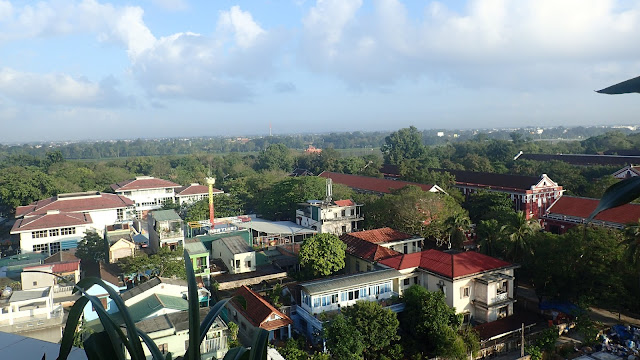









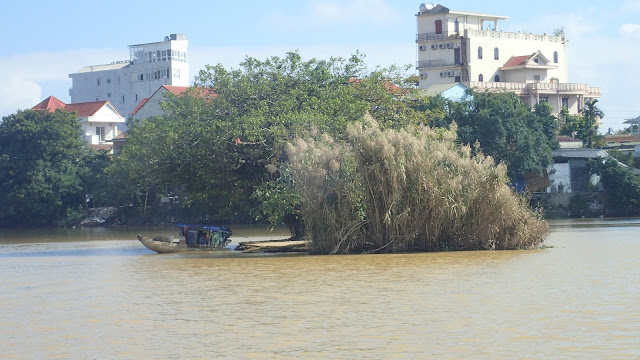
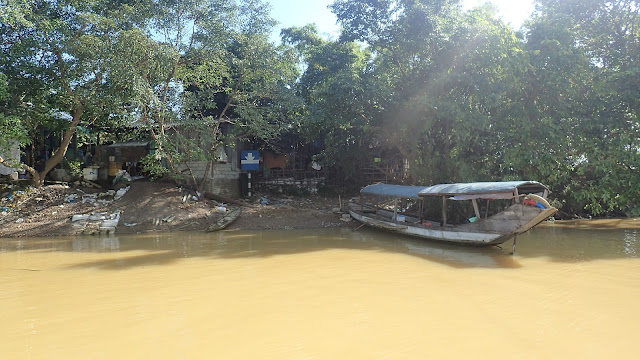





















































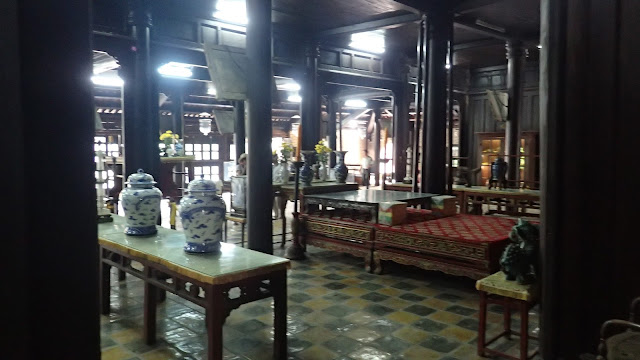









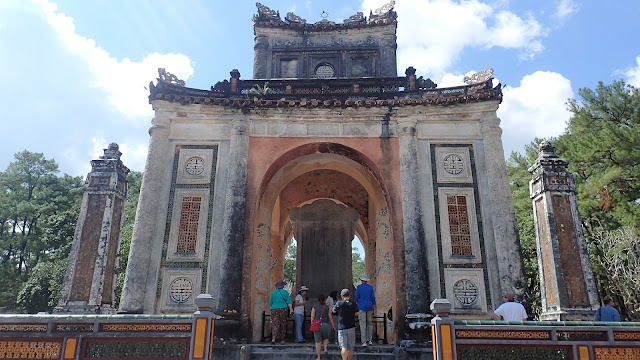















































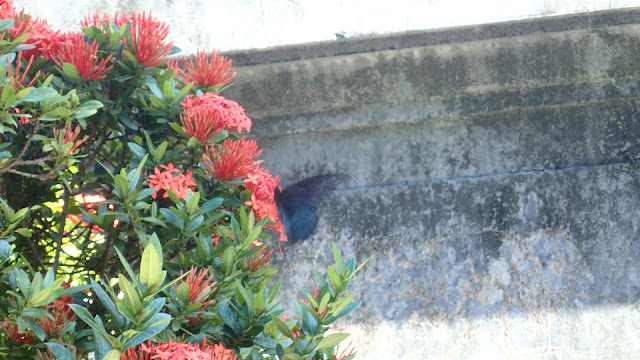

















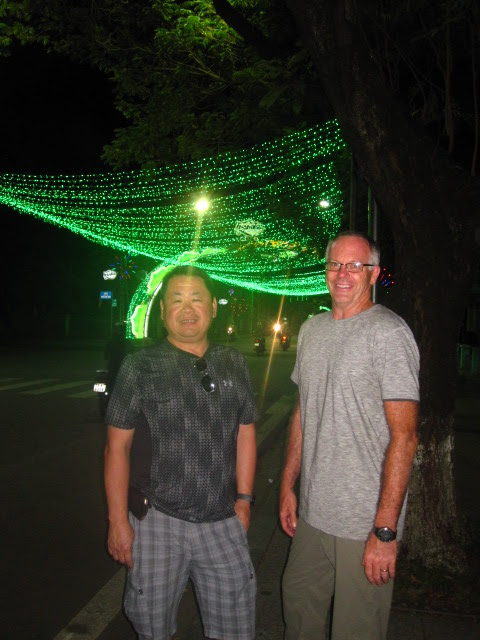

No comments:
Post a Comment